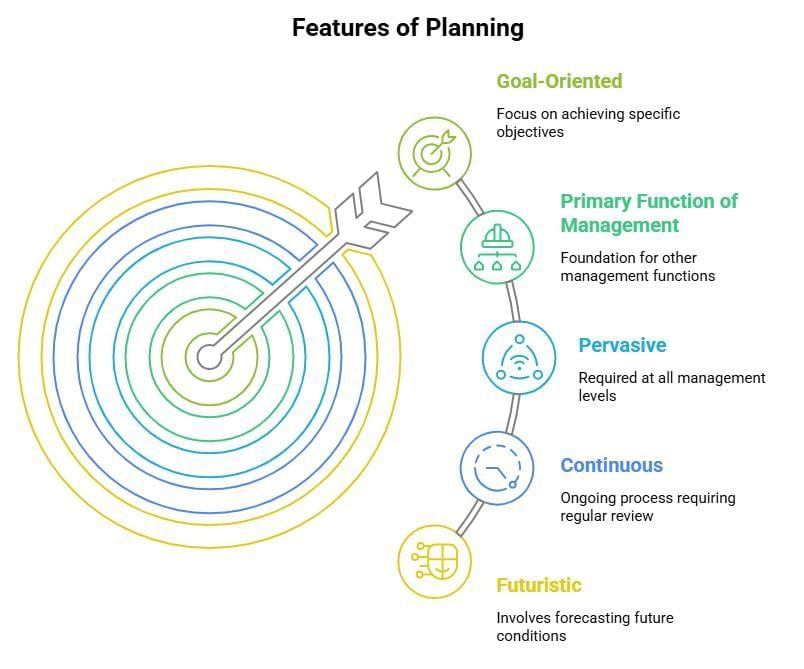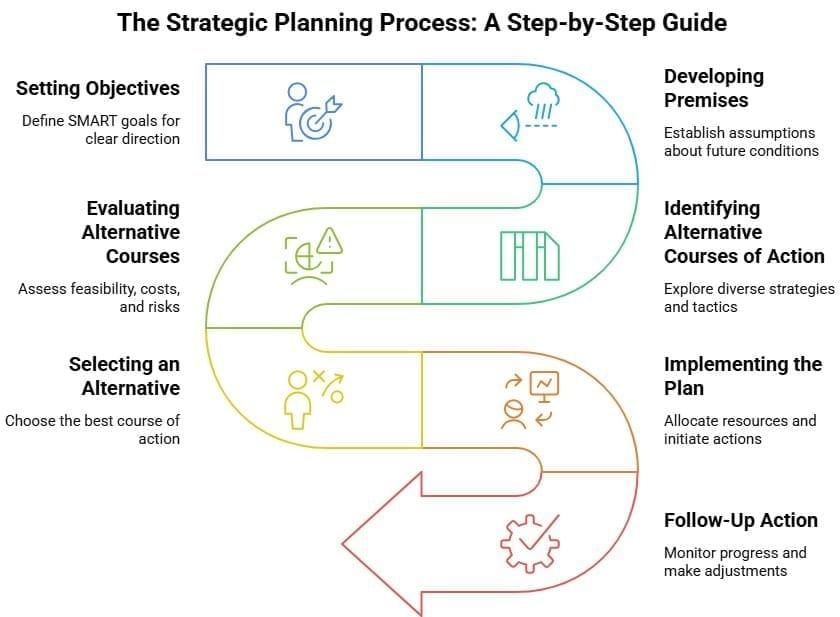Short Notes: Planning | Business Studies (BST) Class 12 - Commerce PDF Download
| Table of contents |

|
| What is Planning? |

|
| Features of Planning |

|
| Importance of Planning |

|
| Limitations of Planning |

|
| Planning Process |

|
| Types of Plans |

|
| Conclusion |

|
What is Planning?
Planning is a systematic process of setting goals and deciding in advance the actions, resources, and timelines needed to achieve them. It helps anticipate future challenges and prepare strategies to move from the current state to the desired goals. Planning ensures coordinated, efficient, and goal-oriented efforts within an organisation.

Features of Planning
Planning has distinct characteristics that define its scope and nature, making it a critical management function:
- Goal-Oriented: Planning is focused on achieving specific, measurable objectives within a defined timeframe, aligning all efforts with organisational goals.
- Primary Function of Management: As the foundation of management, planning precedes other functions like organising, staffing, directing, and controlling, guiding their execution.
- Pervasive: Planning is required at all levels of management (top, middle, and lower) and across all departments, ensuring organisation-wide alignment.
- Continuous: Planning is an ongoing process that requires regular review and adjustment to remain relevant in changing circumstances.
- Futuristic: Planning involves forecasting future conditions and preparing for potential scenarios, making it inherently forward-looking.
- Involves Decision Making: Planning requires analysing alternatives and choosing the best course of action, making it a decision-intensive process.
- Mental Exercise: Planning demands intellectual effort, including analysis, judgment, and creativity, to devise effective strategies.
- Systematic Process: Planning follows a structured approach, including analysing the current situation, setting objectives, evaluating alternatives, and selecting the best plan.
- Flexible: Effective plans are adaptable to changes in the external environment, allowing organisations to adjust strategies as needed.
- Coordination: Planning ensures that activities and resources across departments are synchronised to achieve common goals.
- Resource Allocation: Planning involves identifying and allocating resources (e.g., manpower, finances, materials) efficiently to support goal achievement.
Importance of Planning
Planning is a cornerstone of effective management, enabling organisations to operate with clarity, reduce risks, and achieve their goals efficiently. Its significance lies in the following benefits:
- Provides Direction: By defining objectives and outlining how they will be achieved, planning ensures that all employees work toward a common purpose. Without planning, efforts may become fragmented, leading to inefficiency.
- Reduces Risk of Uncertainty: Planning allows managers to anticipate changes, such as market fluctuations or technological advancements, and develop contingency measures to mitigate risks associated with unpredictability.
- Reduces Overlapping and Wasteful Activities: Through coordinated planning, resources are allocated efficiently, eliminating redundant tasks and minimising waste, which enhances productivity and cost-effectiveness.
- Promotes Innovative Ideas: As the first function of management, planning encourages managers to think creatively, explore new strategies, and develop innovative solutions to achieve objectives.
- Facilitates Decision Making: Planning provides a clear framework of goals and alternatives, enabling managers to evaluate options and select the most viable course of action with confidence.
- Establishes Standards for Controlling: By setting measurable benchmarks, such as sales targets or production quotas, planning provides standards against which actual performance can be evaluated, ensuring effective control.
Limitations of Planning
While planning is essential, it has certain limitations that can affect its effectiveness. These can be categorised as internal and external limitations:
Internal Limitations
- Leads to Rigidity: Detailed plans may discourage flexibility, as managers and employees may resist deviating from predetermined strategies, limiting adaptability.
- Reduces Creativity: Strict adherence to plans, especially when set by top management, can stifle initiative and innovative thinking among lower-level managers and employees.
- Involves Huge Costs: Formulating plans requires significant resources, including time, money, and expertise for research, analysis, and consultation.
- Time-Consuming Process: Developing comprehensive plans can take considerable time, potentially delaying action and implementation.
- Does Not Guarantee Success: Even well-crafted plans may fail due to unforeseen challenges or poor execution, as past successes do not ensure future results.
External Limitations
- May Not Work in a Dynamic Environment: Plans based on future assumptions may become obsolete due to unpredictable external factors like economic shifts, technological changes, or natural calamities.
- Changes in Government Policies: New regulations or policy shifts can disrupt plans, rendering them ineffective.
- Competitor Strategies: Unexpected changes in competitors’ actions can undermine the effectiveness of planned strategies.
- Economic and Social Conditions: Shifts in market demand or societal trends can affect the relevance of plans.
- Natural Calamities: Events like floods or earthquakes can derail even the most robust plans.
- Technological Changes: Rapid advancements may outpace planned strategies, requiring constant updates.
Planning Process
The planning process is a systematic approach to creating effective plans, involving the following steps:
- Setting Objectives: Define specific, measurable, achievable, relevant, and time-bound (SMART) goals for the organisation and its departments. Objectives provide the foundation for all planning activities.
- Developing Premises: Establish assumptions about future conditions, such as market trends, economic factors, or technological advancements, which guide planning decisions.
- Identifying Alternative Courses of Action: Explore multiple ways to achieve objectives, considering various strategies and approaches.
- Evaluating Alternative Courses: Assess each alternative based on feasibility, costs, benefits, risks, and alignment with objectives.
- Selecting an Alternative: Choose the best course of action that is most feasible, profitable, and has the least negative consequences.
- Implementing the Plan: Execute the selected plan by allocating resources, assigning responsibilities, and initiating actions.
- Follow-Up Action: Monitor progress, evaluate performance against objectives, and make adjustments to address deviations or changing conditions.

Types of Plans
Plans are classified into two main categories based on their purpose and frequency of use:
1. Single-Use Plans: These are designed for a specific, one-time project or event and are discarded after use. They address unique situations that do not recur.
Example: A company develops a plan for hosting a product launch event, detailing the budget, marketing campaign, and logistics. Once the event is completed, the plan is no longer relevant but may serve as a reference for future events.
- Types:
- Programme: A detailed plan outlining objectives, policies, procedures, rules, tasks, and resources for a specific project (e.g., a training programme for new employees).
- Budget: A numerical plan forecasting expected results, such as revenue or expenses, for a specific period (e.g., a quarterly sales budget).
2. Standing Plans: These are developed for repetitive activities and used repeatedly over time, with periodic revisions to remain relevant. They ensure consistency in handling recurring situations.
- Example: A company’s recruitment and selection procedure for hiring employees is a standing plan, applied consistently to ensure uniformity and efficiency in hiring across departments.
- Types: Objectives, Strategies, Policies, Procedures, Rules, Methods (explained in the next section).

Basis of Difference Between Single-Use and Standing Plans

The following are the types of plans:
- Objectives: Specific, measurable goals that an organisation aims to achieve within a defined timeframe. They represent the desired future position and guide all planning efforts.
- Example: Increasing market share by 15% within two years.
- Strategy: A long-term plan designed to achieve major objectives, often addressing competitive positioning or responses to external opportunities and threats. Strategies can be internal (e.g., improving operational efficiency) or external (e.g., countering competitor moves).
- Example: Adopting a digital marketing strategy to target younger customers.
- Policy: General guidelines that provide a framework for decision-making, ensuring consistency across the organisation. Policies are flexible and can be adapted as needed.
- Example: A policy to prioritise eco-friendly suppliers for procurement.
- Procedure: A detailed, step-by-step sequence of actions to perform specific tasks, ensuring uniformity and efficiency. Procedures are guides to action that support policies.
- Example: A procedure for processing customer refunds, including verification, approval, and payment steps.
- Rule: A specific statement dictating what must or must not be done in a given situation. Rules are rigid and enforce discipline.
- Example: “No mobile phones allowed during production hours.”
- Method: A standardised, efficient way of performing a task, selected to minimise time and cost. Methods are flexible and can vary based on the task.
- Example: Using online surveys as a method for collecting customer feedback.
- Programme: A comprehensive single-use plan that includes objectives, policies, procedures, rules, tasks, resources, and budgets for a specific project or activity.
- Example: A programme for launching a new product, detailing marketing, production, and distribution plans.
- Budget: A numerical plan forecasting expected results (e.g., revenue, expenses, or sales) for a specific period. Budgets facilitate resource allocation and performance evaluation.
- Example: A monthly advertising budget allocating funds for social media, TV, and print campaigns.
Conclusion
Planning is a vital management function that drives organisational success by setting goals, allocating resources, and preparing for future challenges. It ensures coordinated, efficient efforts through clear direction, risk reduction, waste minimisation, innovation, decision-making support, and control standards. Despite limitations like rigidity, costs, and external uncertainties, its systematic process, varied plan types (single-use and standing), and key terms (objectives, strategies, budgets) enable strategic progress. Flexible and continuous, planning bridges the present and future, making it essential for effective management.|
51 videos|230 docs|49 tests
|
FAQs on Short Notes: Planning - Business Studies (BST) Class 12 - Commerce
| 1. What is the concept of planning in management? |  |
| 2. What are the key features of planning? |  |
| 3. Why is planning considered important in an organization? |  |
| 4. What are some limitations of planning? |  |
| 5. What are the different types of plans used in planning processes? |  |















